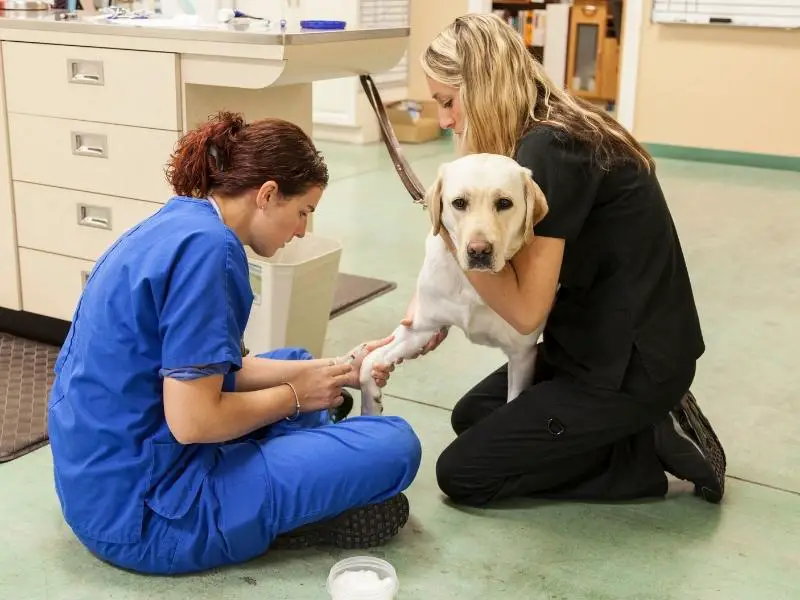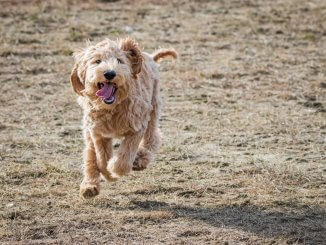The Labrador retriever is a large sporting dog of North American and British origin. These dogs are also commonly referred to as Labradors and Labs.
Labrador retrievers, America’s most popular dog breed, are friendly and outgoing dogs that are sweet-natured, easy-going, and highly affectionate to humans and other animals. These dogs aren’t aggressive to children, people, or animals unless untrained and provoked.
The breed is large and measures 21.5–24.5 inches tall and weighs 55–80 pounds.
The lifespan of a Labrador retriever is generally 10–12 years, as long as the dogs are fed properly and given plenty of exercise. These dogs are highly active, water-loving dogs that need daily exercise.
Labrador retrievers typically cost $50–$1,500.
TABLE OF CONTENTS
Labrador Retriever Characteristics & Overview

| Common names: | Labrador retriever, Labrador, lab |
| Origin: | Newfoundland and England |
| Breed group: | Sporting dog |
| Size: | Large |
| Height: | 21.5–24.5 inches |
| Weight: | 55–80 pounds |
| Colors: | Black, chocolate, yellow |
| Coat: | Double coat, short hair |
| Life expectancy: | 10–12 years |
| Temperament: | Active, outgoing, friendly, high-spirited |
| Shedding: | Heavy |
| Barking tendency: | Low to moderate |
| Cost: | $50–$1,500 |
Origin & Purpose
Labrador retrievers are originally from an island called Newfoundland off the coast of Canada, where they were known as St. John’s dogs before they were shipped to England.
After arriving in England, St. John’s dogs were refined by breeders and called Labradors, after the region of Labrador in Newfoundland. The breed was officially recognized by the American Kennel Club (AKC) as a Labrador retriever in the early 1900s.
St. John’s dogs were known to accompany fishermen and retrieve the fishing nets filled with fish from the cold water. In England, Labradors were bred for their water retrieving abilities to assist hunters in fetching ducks.
Today, Labrador retrievers are still used as working dogs — alongside hunters, as bomb detection dogs, in search and rescue missions, and as service and therapy dogs.
Lifespan
Labrador retrievers live for 10–12 years if they are cared for properly, fed a high-quality diet, and given enough exercise.
While these dogs are generally healthy, the breed is susceptible to certain conditions that may shorten its lifespan. These conditions include tricuspid valve dysplasia (TVD), gastric dilatation-volvulus, and myopathy.
Labrador Retriever Appearance

Labrador retrievers are large dogs with an athletic build and a black, chocolate, or yellow thick, double coat. These dogs have short hair and are characterized by a sweet face and a thick, tapering tail.
Height and Weight
Labrador retrievers are considered large dogs, with a height at the withers of 21.5–24.5 inches, and a weight of 55–80 pounds. Grown males stand 22.5–24.5 inches tall and weigh 65–80 pounds. Mature females are generally 21.5–23.5 inches tall and weigh 55–70 pounds.
Labrador retriever puppies grow relatively fast and can reach their full height between the ages of six months and one year. They usually reach their mature weight at around two years of age.
Colors
Labrador retrievers have coats that are either black, chocolate, or yellow. While black used to be the most common color, chocolate and yellow Labradors are growing in popularity. Less-common Lab colors are red and polar white (a variation of the yellow coat color).
A rare Labrador color is silver, which appears as a shiny chocolate or grayish color, often accompanied by distinct blue eyes.
Coat
Labrador retrievers have a double coat made up of a thick topcoat and a weather/water-resistant undercoat. These dogs have short to medium-length hair and are heavy shedders. Shedding may increase during spring and autumn or persist year-round in temperate climates.
Paws and Tail
As descendants of waterdogs, Labrador retrievers have distinct adaptations on their paws and tail to improve their swimming abilities.
Their paws are webbed to help them move through water as well. Their paws also provide comfort in colder conditions, such as preventing ice from sticking between the toes.
Labrador retrievers have a tapered, otter-like tail that moves through the water like a propeller to help the dog swim faster.
Body Types
There are two recognizable types of Labrador retrievers that differ based on body type. The American Labrador is known as a working dog or field variety and has a narrower head, a longer muzzle, lighter bones, and a longer coat.
This variety of Labrador tends to have more energy than the English Labrador retriever and is better suited as a working dog.
The show variety, also known as the English Labrador retriever, has a denser coat, shorter legs, and a broader head. This variety of Labrador is better suited as a family pet.
Personality and Temperament

According to the AKC temperament guide, Labrador retrievers are highly adaptable dogs that are intelligent, outgoing, and eager to please.
These dogs are usually not aggressive or shy towards people and other animals. They offer affection and love to families, while being gentle with children. This breed also isn’t bothered by loud noises.
This dog has high energy levels and needs active families and plenty of attention to keep the breed happy. While they are not often wanderers, the Labrador’s curious nature may cause them to stray by following exciting scents or animals.
Labrador retrievers enjoy having something in their mouths and, without proper training, they may grab onto people or furniture if they don’t have enough toys.
Barking
With proper care, Labrador retrievers are usually minimal barkers and may only bark to alert owners of strangers approaching. These dogs are friendly to people, including strangers, so they don’t make good guard dogs.
These dogs bark often if they are left alone for long periods or if they aren’t given enough exercise or mental stimulation.
Labrador Retriever Care

Labrador retrievers have a short coat that only needs occasional grooming, although heavy shedding means that they need regular brushing.
Labs are highly energetic and need plenty of exercise and mental stimulation, along with a healthy diet.
Food Needs
Feed a Labrador retriever 2.5–3 cups of high-quality, dry dog food split into two meals per day. The amount will depend on the dog’s weight, build, age, and activity level. It’s essential to note that a Labrador needs the right diet to maintain optimal health.
Labs love to eat and are prone to becoming obese if they are overfed or if they have access to food all day.
These dogs will steal food from countertops and pantries if given the chance, which can also lead to obesity.
Grooming Needs
As heavy shedders, Labrador retrievers should be brushed weekly, or even daily, when they’re shedding. They should also be bathed once a month. Dogs who swim often and get dirty outside will need to be cleaned more regularly.
Due to Labrador retrievers’ fold-over ears and love for swimming, their ears should be checked weekly for signs of infection. You should also plan to regularly clean their ears using a damp cotton ball.
Check for rashes, bumps, and sores on a Labrador retriever’s body during grooming sessions.
Exercise Needs
Labrador retrievers are energetic and require attention and lots of exercise to prevent them from becoming destructive.
Give these dogs an hour or two of exercise each day in the form of walks, runs, swims, or a vigorous game of fetch. Be careful not to overexert this breed, as it will continue playing — or working — for hours longer than needed. This could hurt their bones and joints.
Young Labs should be given shorter play sessions throughout the day to keep their growing bones and joints safe.
Mental Needs
In addition to daily exercise, Labrador retrievers need mental stimulation to stay happy and healthy due to their intelligent and curious nature.
A good game of fetch is one way to stimulate a Labrador. Learning new tricks, playing with puzzle toys, or sniffing and exploring areas on walks are other great ways to stimulate a lab.
Common Health Concerns
Labrador retrievers are generally healthy dogs that live up to 10–12 years. However, these dogs are susceptible to certain health conditions that are common in larger breeds.
A few health conditions to look for include:
- Osteochondritis Dissecans (OCD): A condition caused by the improper growth of cartilage in a dog’s joints within the elbows or shoulders. The main symptom of OCD is a dog that can’t bend its elbow properly, which is usually evident in dogs aged four to nine months old. This condition is often caused by high-protein foods or overfeeding of growth formula in puppies.
- Elbow Dysplasia: A heritable condition, that is commonly found in large dogs, caused by different growth rates of the dog’s elbow bones. Common symptoms are lameness in the dog’s legs along with pain. This condition can be corrected through surgery and pain medication.
- Epilepsy: A condition that causes mild or severe seizures, which the Lab displays as frantic running, staggering, or hiding. A trip to the vet is necessary to determine the cause and treatment.
- Tricuspid Valve Dysplasia (TVD): A condition that affects the heart and is becoming more common in the Labrador breed. The dogs are born with TVD due to a deformation of the heart valves. TVD can cause no problems in a dog but can lead to death. Treatment options are still being researched for this condition.
- Ear Infections: A condition that is common in Labradors because of their love of swimming and ears that hold moisture. A weekly check of the Lab’s ears can determine whether an ear infection is forming. A vet can prescribe medication to clear infections.
- Gastric Dilatation-Volvulus: A condition, commonly known as bloat, that occurs in large, deep-chested dogs. It is often caused by large meals, rapid eating and drinking, and strenuous exercise soon after meals. Symptoms of bloat include rapid heart rate, lethargy, depression, weakness, retching without vomiting, and excessive drooling. Labrador retrievers require immediate veterinary care if these symptoms are evident.
Training

Labrador retrievers are generally easy to train because of their easy-going nature and eager-to-please attitudes. However, their energetic behavior can cause difficulties.
Exposing a Labrador puppy to various people, animals, and sounds during the first seven weeks will help them develop into well-adjusted adults.
This breed excels in obedience training and enjoys group training sessions due to its social nature. The upbeat personality of Labs means they are more accepting of positive reinforcement training methods.
Recall training is necessary to prevent the dogs from wandering off when smelling interesting scents outdoors.
Labrador Retriever Price

The Labrador retriever is an inexpensive breed to buy, but the price varies depending on whether the dog is adopted or bought from a reputable breeder.
Caring for these dogs can cost a significant amount of money each year.
How Much Is a Labrador Retriever?
A Labrador retriever typically costs $50 to $1,500. Adopting a Labrador puppy will cost between $50 and $350. A Lab from a reputable breeder will cost between $700 and $1,500.
Well-known breeders can charge up to $2,500 for a healthy Labrador puppy.
Rescuing and adopting this breed is much cheaper than buying. Some shelters will also provide first-year vaccinations as part of the cost of the dog.
How Much Does it Cost to Own a Labrador Retriever?
Caring for a Labrador retriever will cost $2,000–$3,000 in the first year, which includes initial vet fees, a dog bed and toys, puppy food, and training.
Once the Lab has matured, the yearly cost of care will be around $2,000.
Is a Labrador Retriever Right for You?

Labrador retrievers will bring lively energy, a loving attitude, and a gentle personality to a family or an individual owner. However, they may not suit everyone because of their large size and heavy shedding.
Who Should Get a Lab?
Labrador retrievers are well-suited for active and playful families with young children. They are also good for single owners who are looking for a gentle companion.
These dogs will need a large living area with a big yard to play in, although they can adapt to a smaller space if they are given plenty of daily exercise and opportunities to explore.
Labradors are loving dogs who are protective of their families and friendly to strangers. As long as the dogs are taught how to behave around young children (and the children are taught how to treat dogs correctly), the two will be friends for life.
Who Should Not Get a Lab?
Labrador retrievers are heavy shedders, making the breed unsuitable for owners who don’t want hair all over their clothes and furniture. Due to their heavy shedding, labs are also not suitable for people with allergies.
As active sporting dogs, Labradors are not suited for inactive households that will not provide plenty of exercise and mental stimulation.
Labrador retrievers are also highly sociable and should have company for most of the day. These dogs are not suitable for owners who will leave the dog alone for long periods, as they are prone to separation anxiety, which can lead to destructive behavior and excessive barking.
Labrador Retriever Mixes
Looking for a dog with the personality of a lab but the physical traits of another breed? Check out the following Labrador retriever mixed breeds:







Be the first to comment